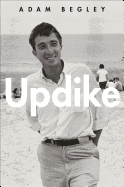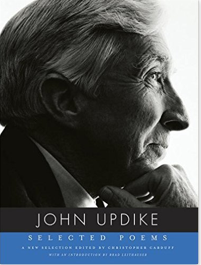The Guardian published a quiz titled “Great books that publishers rejected” that would have been more satisfying had they mentioned what publisher was doing the rejection. Even so, it’s still quick and fun.

The Guardian published a quiz titled “Great books that publishers rejected” that would have been more satisfying had they mentioned what publisher was doing the rejection. Even so, it’s still quick and fun.
In a piece written for The Guardian, Updike biographer Adam Begley noted, and not without some experience, “Widows and biographers don’t get along. . . . To the widow, or widower, or surviving children, any biography that digs deep into the private life of the subject is almost guaranteed to be obnoxious.
 “There are exceptions: John Cheever’s family allowed Blake Bailey full and free access to papers they knew (or at least strongly suspected) contained sad and sordid secrets. But it’s a safe bet that any family will want the biographer to focus on public achievements, not private peccadilloes. You can’t libel the dead, but revealing the seamy side, or simply speaking ill of them, invariably causes collateral damage, mostly to descendants but occasionally (think David Foster Wallace) to parents.”
“There are exceptions: John Cheever’s family allowed Blake Bailey full and free access to papers they knew (or at least strongly suspected) contained sad and sordid secrets. But it’s a safe bet that any family will want the biographer to focus on public achievements, not private peccadilloes. You can’t libel the dead, but revealing the seamy side, or simply speaking ill of them, invariably causes collateral damage, mostly to descendants but occasionally (think David Foster Wallace) to parents.”
Begley concludes that while “literary lives are tasteful, biographies are not. I know this to be true because when I was writing my biography of John Updike, I always insisted, snobbishly, that it was a book about how Updike’s life shaped his work. I looked down my nose at sensational biographies that aimed to satisfy the prurient curiosity of that mythical creature, the ‘average’ reader. The prospect of digging up dirt, even accidentally, appalled me. It made me squeamish.
“Yet because Updike was a self-confessed serial philanderer, I was repeatedly quizzed—by my friends and his—about his sex life. It was the inescapable topic. I righteously declined to name names, and omitted as many graphic details as I could,” he writes. “And then it emerged, after I finished the book, that there was a character who had spent the last three years of Updike’s life sifting through the author’s trash, creeping up to the bottom of Updike’s driveway and hauling off garbage bags so he could hunt at his leisure for collectible memorabilia—anything with Updike’s handwriting on it, from discarded drafts to cancelled cheques. This revelation sickened me, in part because I could see, obscurely, a parallel with what I’d done.
“Tasteful biographers sift through archives, not trash cans. But what they look for is biographical gold (very valuable dirt), and that nearly always involves something written for private purposes: unpublished letters, say, or a diary no one knew about. Is unearthing this treasure very different from going through the garbage? I used to be sure, now I’m not.”
“Dirt for art’s sake: what’s offensive and what’s essential in author biographies?”
in an essay “drawn from The ’50s: The Story of a Decade, an anthology of New Yorker articles, stories, and poems” published the last week in October, Jonathan Franzen considers the writers and stories that came to characterize the magazine’s fiction.
“Along with John Updike and Ann Beattie, Cheever was the paradigmatic ‘New Yorker story’ writer, Franzen says, adding, “While Cheever and Updike were creating the main template for the New Yorker story, regional variants were flourishing.”
 At Schlemiel Theory, subtitles “The Place Where the Laugh Laughs at the Laugh,” Menachem Feuer published a piece titled “The Rise and Fall of American Dreams: On John Updike’s ‘Rabbit, Run’.” In it, he considers the opening scene in Rabbit, Run where an older Rabbit plays basketball with young men and notices a “natural” among them. Then he realizes that his own basketball fame has faded: “They’ve not forgotten him: worse, they never heard of him.”
At Schlemiel Theory, subtitles “The Place Where the Laugh Laughs at the Laugh,” Menachem Feuer published a piece titled “The Rise and Fall of American Dreams: On John Updike’s ‘Rabbit, Run’.” In it, he considers the opening scene in Rabbit, Run where an older Rabbit plays basketball with young men and notices a “natural” among them. Then he realizes that his own basketball fame has faded: “They’ve not forgotten him: worse, they never heard of him.”
“What Updike manages to do in this passage is to show the contradictions at the heart of the American dream. It may lift you up but at a certain point you may have to realize that you’re just one-in-a-million. But, to be sure, the struggle between being someone and being no-one is at the core of modernist art, literature, and philosophy. The question we have, as readers, is how Rabbit deals with his sinking into significance. Will he give up, will he try to be someone, or will he just . . . run away? Will he hurt people along the way?
 On November 3, 2015, Jason Fernandes posted a retro review of The Witches of Eastwick, the book he read years ago as an introduction to John Updike, on his blog, Rants & Raves.
On November 3, 2015, Jason Fernandes posted a retro review of The Witches of Eastwick, the book he read years ago as an introduction to John Updike, on his blog, Rants & Raves.
“From the opening pages of The Witches of Eastwick, I was immediately put to mind of Pride and Prejudice. That might sound like a strange connection to make,” he writes. “Whether this is just a coincidence or Updike is consciously having some fun with the reader is something I cannot say. Neither would surprise me. But it did give me a warm first impression and the sense that I was in for a treat. . . .
“The prose is exquisite. I have been fed on mostly contemporary fiction in recent years, and even the ‘modern classics’ I have read have not impressed me greatly. This novel was a welcome return to a higher class of writing,” he writes.
“Book Review: The Witches of Eastwick”
 Jim Higgins, of the Milwaukee Journal Sentinel, has been reading his way through the two-volume Library of America Collected Stories, but decided to take a detour this week and read and respond to the recently published volume of Updike’s Selected Poems. This post he reads and briefly comments on “Ex-Basketball Player,” “Seven Stanzas at Easter,” and “Fever.”
Jim Higgins, of the Milwaukee Journal Sentinel, has been reading his way through the two-volume Library of America Collected Stories, but decided to take a detour this week and read and respond to the recently published volume of Updike’s Selected Poems. This post he reads and briefly comments on “Ex-Basketball Player,” “Seven Stanzas at Easter,” and “Fever.”
 John Updike gets a brief mention in Adam Gopnik’s review of a new New York Review of Books Classics anthology of Max Beerbohm‘s work “with the unfortunately patronizing title The Prince of Minor Writers.”
John Updike gets a brief mention in Adam Gopnik’s review of a new New York Review of Books Classics anthology of Max Beerbohm‘s work “with the unfortunately patronizing title The Prince of Minor Writers.”
Updike, he reminds us, had written the introduction to a previous N.Y.R.B. Classics reprint edition of Beerbohm’s Seven Men.
Full story: “The Comparable Max; Max Beerbohm’s cult of the diminutive”
 The reviews have started coming in for John Updike: Selected Poems, edited by Christopher Carduff and published by Alfred A. Knopf (cloth, 320pp., $30). To keep them consolidated we will add new reviews to this page as we become aware of them, so check back. Below is a link to an abridged version of poet Brad Leithauser’s introduction and reviews arranged according to date of publication.
The reviews have started coming in for John Updike: Selected Poems, edited by Christopher Carduff and published by Alfred A. Knopf (cloth, 320pp., $30). To keep them consolidated we will add new reviews to this page as we become aware of them, so check back. Below is a link to an abridged version of poet Brad Leithauser’s introduction and reviews arranged according to date of publication.
“Updike’s naked poetry.” Brad Leithauser. The New Criterion. October 2015. “To my mind, he was the twentieth-century American writer who created the greatest number of zingers—sentences you want to place check marks beside, and extract from their surroundings to scrutinize as separate entities, and eventually perhaps tinker with, in an attempt to understand better why they perform so well. (In this, he was to the twentieth century what Henry James was to the nineteenth.)”
“Selected Poems establishes Updike as a serious poet.” James Plath. The John Updike Society. 15 October 2015. “Collected and compressed, this volume offers proof that Updike is in fact a gifted poet whose verse should not be ignored. He displays a poetic range that would be impressive even if it had come from an award-winning poet like [Brad] Leithauser.”
“Book Review: Updike compilation of poems evocative.” Peter Tonguette. The Columbus Dispatch. 1 November 2015. “Updike may have been a part-time poet, but this carefully chosen selection shows his facility with the form.
“Boston Boys: The poetry of John Wieners and John Updike.” Dan Chiasson. The New Yorker. 2 November 2015. “Updike’s poems are not trifles; he could be surprisingly formally ambitious, even experimental. The problem is that all of his poems about strain, discomfort, and regret cheer him, and we don’t associate cheer with great poetry. The poems often feel like the by-products of the happy diversion they provided their author while he was writing them. . . . His best poems are mild evocations of local eccentricity, seasonal anomie, domestic frisson.”
“Review: John Updike the poet?” Michael D. Langan. NBC-2. 4 December 2015. “For me, Updike seemed to be able to write a poem about anything. I’d hazard that if he blew on the inside of a window pane during a harsh winter in southeastern Pennsylvania, hurriedly scribbling a few lines with his finger on the frost, a lasting poem would appear.”
“Updike’s Violin.” Jonathan Galassi. The New York Review of Books. 17 December 2015. “You could almost call his early verse ‘applied poetry,’ entertainments written with his left hand, as it were. As time went by, though, he distinguished his light verse from what he later called his ‘secret bliss.’ ‘My poems are my oeuvre’s beloved waifs,’ he wrote in the preface to his 1993 Collected Poems. Lurking in the shadows of Updike’s will to shine is another, more surreptitious aspiration, one he never fully came to terms with.”
“Updike in Verse; Has justice been done to a lifetime of poetry?” Joseph Bottum. The [Weekly Standard] Magazine. 21 December 2015. “No, this is a disappointment. To read the 132 poems chosen by this volume’s editor, Christopher Carduff, is to realize that John Updike is not a poet well served by the popular impulse that reduces a large body of work to a greatest-hits anthology.
“Review: Men of Letters, John Updike and Jim Harrison, and Their Poems.” Dwight Garner. The New York Times. 22 December 2015. “Updike’s best verse is presented now in Selected Poems . . . with a wise introduction by Brad Leithauser. Updike’s gift for close observation, in these poems as elsewhere, is near to supernatural.”
“Staff Picks: The Poetry of John Updike.” Rand Richards Cooper. Commonweal. 23 December 2015. “Like his prose, Updike’s poetry—much of it written in variations on the sonnet—highlights his skill in noticing the world, and his life in it, in trenchant and surprising ways. The poems convey wry humor, exquisite attentiveness to daily life, and an abiding preoccupation with mortality and time.”
“Likely Stories: Selected Poems by John Updike.” Jim McKeown. KWBU (Texas Public Radio). 12 May 2016. “I wish I had an hour or two to read to you aloud more of the words and phrases, the mastery of language so evident in everything Updike wrote. . . . Updike can evoke all those feelings as quickly and lightly as a feather duster, capturing motes of images and emotions. John Updike: Selected Poems is a fantastic place to explore one of the great writers of the 20th century. 5 stars.”
 John Updike Society member Lang Zimmerman, whom society members may have met at the most recent conference in Reading, Pa., has become the first U.S.-based lifetime benefactor. Zimmerman is vice president of Yelcot, a family-owned communications company based in Mountain Home, Arkansas, and is also commissioner for the Arkansas Economic Development Commission. In a note he added that his donation was written, appropriately, using a pen made from Updike’s dogwood tree.
John Updike Society member Lang Zimmerman, whom society members may have met at the most recent conference in Reading, Pa., has become the first U.S.-based lifetime benefactor. Zimmerman is vice president of Yelcot, a family-owned communications company based in Mountain Home, Arkansas, and is also commissioner for the Arkansas Economic Development Commission. In a note he added that his donation was written, appropriately, using a pen made from Updike’s dogwood tree.
The new dues structure announced in August included options to become a lifetime member ($500) and a lifetime benefactor ($1000). So far no one has chosen to become a lifetime member, but Zimmerman now joins Takashi Nakatani as the society’s lifetime benefactors.
Publishers Weekly asked Christopher Carduff, “who was handpicked by John Updike to edit the Library of America edition of his work” and “also edits the posthumous Updike publications for Knopf, the later of which, John Updike: Selected Poems, will be published this month,” to choose 10 of “his favorite books by Updike in a variety of genres.”
The Centaur, which won the National Book Award, didn’t make Carduff’s list, nor did any of the so-called Scarlet Letter trilogy novels or the Bech books. Neither did Midpoint, Updike’s mid-life poetic crisis, nor Couples, the steamy novel that vaulted Updike into national prominence.
Click here to see Carduff’s “10 Best John Updike Books.”